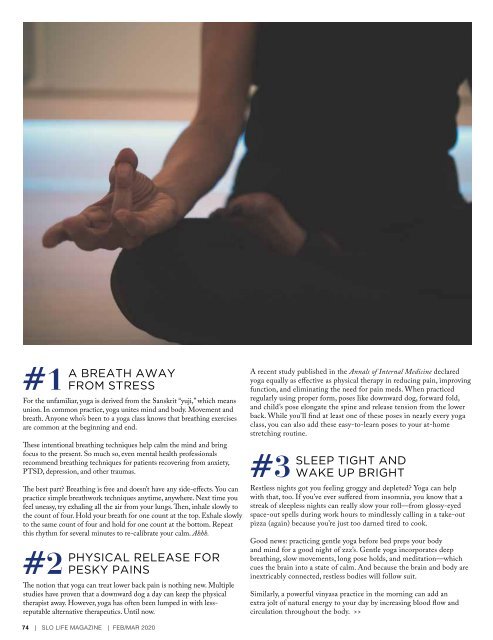SLO LIFE FebMar 2020
Create successful ePaper yourself
Turn your PDF publications into a flip-book with our unique Google optimized e-Paper software.
#1<br />
A BREATH AWAY<br />
FROM STRESS<br />
For the unfamiliar, yoga is derived from the Sanskrit “yuji,” which means<br />
union. In common practice, yoga unites mind and body. Movement and<br />
breath. Anyone who’s been to a yoga class knows that breathing exercises<br />
are common at the beginning and end.<br />
These intentional breathing techniques help calm the mind and bring<br />
focus to the present. So much so, even mental health professionals<br />
recommend breathing techniques for patients recovering from anxiety,<br />
PTSD, depression, and other traumas.<br />
The best part? Breathing is free and doesn’t have any side-effects. You can<br />
practice simple breathwork techniques anytime, anywhere. Next time you<br />
feel uneasy, try exhaling all the air from your lungs. Then, inhale slowly to<br />
the count of four. Hold your breath for one count at the top. Exhale slowly<br />
to the same count of four and hold for one count at the bottom. Repeat<br />
this rhythm for several minutes to re-calibrate your calm. Ahhh.<br />
#2<br />
PHYSICAL RELEASE FOR<br />
PESKY PAINS<br />
The notion that yoga can treat lower back pain is nothing new. Multiple<br />
studies have proven that a downward dog a day can keep the physical<br />
therapist away. However, yoga has often been lumped in with lessreputable<br />
alternative therapeutics. Until now.<br />
A recent study published in the Annals of Internal Medicine declared<br />
yoga equally as effective as physical therapy in reducing pain, improving<br />
function, and eliminating the need for pain meds. When practiced<br />
regularly using proper form, poses like downward dog, forward fold,<br />
and child’s pose elongate the spine and release tension from the lower<br />
back. While you’ll find at least one of these poses in nearly every yoga<br />
class, you can also add these easy-to-learn poses to your at-home<br />
stretching routine.<br />
#3<br />
SLEEP TIGHT AND<br />
WAKE UP BRIGHT<br />
Restless nights got you feeling groggy and depleted? Yoga can help<br />
with that, too. If you’ve ever suffered from insomnia, you know that a<br />
streak of sleepless nights can really slow your roll—from glossy-eyed<br />
space-out spells during work hours to mindlessly calling in a take-out<br />
pizza (again) because you’re just too darned tired to cook.<br />
Good news: practicing gentle yoga before bed preps your body<br />
and mind for a good night of zzz’s. Gentle yoga incorporates deep<br />
breathing, slow movements, long pose holds, and meditation—which<br />
cues the brain into a state of calm. And because the brain and body are<br />
inextricably connected, restless bodies will follow suit.<br />
Similarly, a powerful vinyasa practice in the morning can add an<br />
extra jolt of natural energy to your day by increasing blood flow and<br />
circulation throughout the body. >><br />
74 | <strong>SLO</strong> <strong>LIFE</strong> MAGAZINE | FEB/MAR <strong>2020</strong>


















